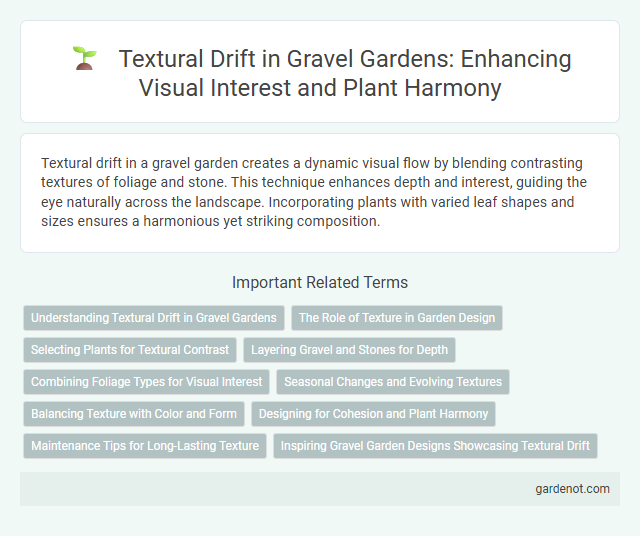Textural drift in a gravel garden creates a dynamic visual flow by blending contrasting textures of foliage and stone. This technique enhances depth and interest, guiding the eye naturally across the landscape. Incorporating plants with varied leaf shapes and sizes ensures a harmonious yet striking composition.
Understanding Textural Drift in Gravel Gardens
Textural drift in gravel gardens refers to the gradual change in the visual and tactile qualities of gravel surfaces caused by factors such as weathering, compaction, and plant growth. Understanding textural drift helps gardeners anticipate maintenance needs and select appropriate gravel types to ensure long-term aesthetic appeal. Monitoring changes in gravel texture enhances garden design by balancing durability with evolving natural characteristics.
The Role of Texture in Garden Design
Texture plays a crucial role in garden design by creating visual interest and enhancing the tactile experience within a gravel garden. Combining coarse gravel with fine-textured plants like ornamental grasses or soft mosses generates a dynamic contrast that guides the eye and adds depth. Strategic use of varied textures helps define spaces and balances the roughness of gravel with softer botanical elements, promoting harmony and aesthetic appeal.
Selecting Plants for Textural Contrast
Selecting plants for textural contrast in a gravel garden enhances visual interest and depth by combining coarse-grained foliage like ornamental grasses with fine-textured plants such as lavender or thyme. Incorporating succulents with fleshy leaves alongside airy, feathery perennials creates dynamic layers that thrive in well-drained gravel beds. Emphasizing a mix of textures not only improves aesthetic appeal but also supports biodiversity by attracting various pollinators.
Layering Gravel and Stones for Depth
Layering gravel and stones strategically enhances textural drift by creating depth and visual interest in a gravel garden. Using varied sizes, colors, and shapes of materials facilitates natural transitions between layers, simulating organic landscapes. This approach promotes effective drainage while emphasizing contrast and dimension.
Combining Foliage Types for Visual Interest
Combining diverse foliage types in a gravel garden enhances textural drift by contrasting fine, feathery leaves with broad, bold ones to create dynamic visual interest. Varieties like ornamental grasses, succulents, and evergreens offer a rich palette of shapes and textures that complement the gravel's rough texture. Strategic plant placement amplifies depth and movement, making the garden visually engaging throughout seasons.
Seasonal Changes and Evolving Textures
Textural drift in a gravel garden highlights the dynamic interplay of seasonal changes as plants transition through growth stages, bloom cycles, and dormancy periods. Evolving textures arise from the contrast between fine gravel surfaces and the coarser, changing foliage of perennials and ornamental grasses throughout spring, summer, and autumn. This continuous transformation enhances visual interest and depth, creating a living tapestry that matures naturally with the garden's environment.
Balancing Texture with Color and Form
Textural drift in gravel gardens enhances visual interest by balancing rough, coarse textures with softer, finer elements, creating harmony across the landscape. Complementing this textural variety with strategic color choices and contrasting plant forms intensifies depth and dimension, guiding the eye naturally. Utilizing diverse foliage textures alongside gravel's gritty surface achieves a cohesive, dynamic design that highlights both texture and color in unison.
Designing for Cohesion and Plant Harmony
Textural drift in gravel gardens enhances cohesion by strategically grouping plants with complementary foliage patterns and sizes to create seamless transitions. Incorporating a variety of textures--from fine grasses to coarse-leaved succulents--balances visual interest while maintaining harmony within the landscape. This approach promotes plant health by minimizing competition and emphasizing natural growth rhythms, ensuring a unified and thriving garden ecosystem.
Maintenance Tips for Long-Lasting Texture
Textural drift in gravel gardens can be minimized by regularly raking the gravel to redistribute particles evenly and prevent compaction. Incorporating a mix of gravel sizes and periodic removal of debris helps maintain consistent texture and drainage. Implementing edge restraints further reduces gravel displacement, ensuring a durable and visually appealing garden surface.
Inspiring Gravel Garden Designs Showcasing Textural Drift
Inspiring gravel garden designs showcase textural drift through the strategic layering of diverse gravel sizes and complementary plants, creating dynamic visual interest and natural flow. Textural drift emphasizes organic movement by blending coarse gravel with softer, fine textures and contrasting foliage, enhancing depth and tactile appeal. This design approach maximizes low-maintenance gardening benefits while transforming outdoor spaces into serene, artful retreats.
Textural drift Infographic

 gardenot.com
gardenot.com